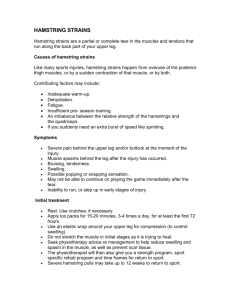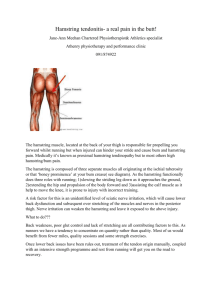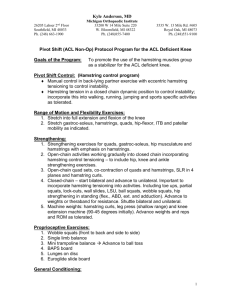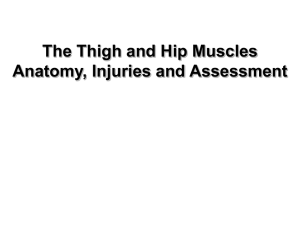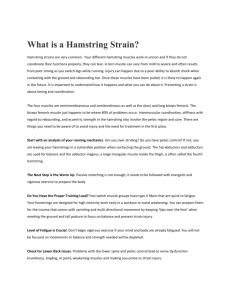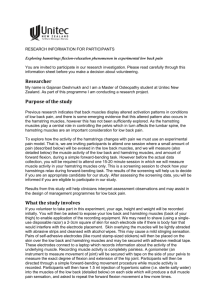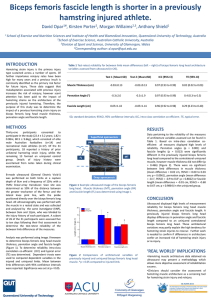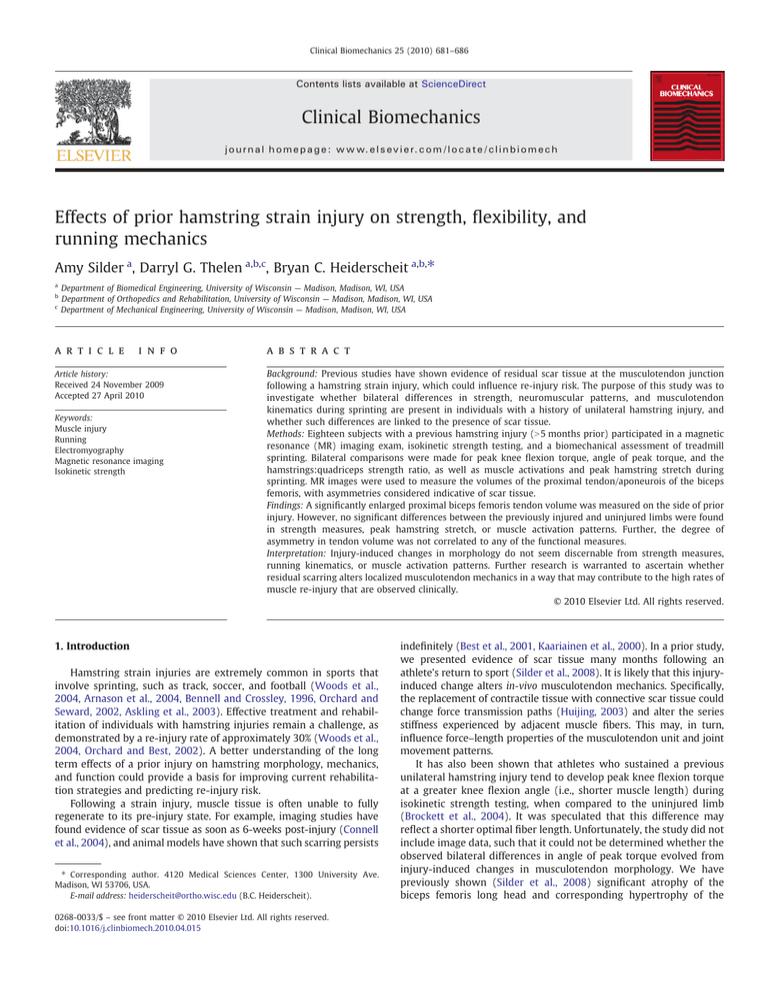
Clinical Biomechanics 25 (2010) 681–686
Contents lists available at ScienceDirect
Clinical Biomechanics
j o u r n a l h o m e p a g e : w w w. e l s ev i e r. c o m / l o c a t e / c l i n b i o m e c h
Effects of prior hamstring strain injury on strength, flexibility, and
running mechanics
Amy Silder a, Darryl G. Thelen a,b,c, Bryan C. Heiderscheit a,b,⁎
a
b
c
Department of Biomedical Engineering, University of Wisconsin — Madison, Madison, WI, USA
Department of Orthopedics and Rehabilitation, University of Wisconsin — Madison, Madison, WI, USA
Department of Mechanical Engineering, University of Wisconsin — Madison, Madison, WI, USA
a r t i c l e
i n f o
Article history:
Received 24 November 2009
Accepted 27 April 2010
Keywords:
Muscle injury
Running
Electromyography
Magnetic resonance imaging
Isokinetic strength
a b s t r a c t
Background: Previous studies have shown evidence of residual scar tissue at the musculotendon junction
following a hamstring strain injury, which could influence re-injury risk. The purpose of this study was to
investigate whether bilateral differences in strength, neuromuscular patterns, and musculotendon
kinematics during sprinting are present in individuals with a history of unilateral hamstring injury, and
whether such differences are linked to the presence of scar tissue.
Methods: Eighteen subjects with a previous hamstring injury (N5 months prior) participated in a magnetic
resonance (MR) imaging exam, isokinetic strength testing, and a biomechanical assessment of treadmill
sprinting. Bilateral comparisons were made for peak knee flexion torque, angle of peak torque, and the
hamstrings:quadriceps strength ratio, as well as muscle activations and peak hamstring stretch during
sprinting. MR images were used to measure the volumes of the proximal tendon/aponeurois of the biceps
femoris, with asymmetries considered indicative of scar tissue.
Findings: A significantly enlarged proximal biceps femoris tendon volume was measured on the side of prior
injury. However, no significant differences between the previously injured and uninjured limbs were found
in strength measures, peak hamstring stretch, or muscle activation patterns. Further, the degree of
asymmetry in tendon volume was not correlated to any of the functional measures.
Interpretation: Injury-induced changes in morphology do not seem discernable from strength measures,
running kinematics, or muscle activation patterns. Further research is warranted to ascertain whether
residual scarring alters localized musculotendon mechanics in a way that may contribute to the high rates of
muscle re-injury that are observed clinically.
© 2010 Elsevier Ltd. All rights reserved.
1. Introduction
Hamstring strain injuries are extremely common in sports that
involve sprinting, such as track, soccer, and football (Woods et al.,
2004, Arnason et al., 2004, Bennell and Crossley, 1996, Orchard and
Seward, 2002, Askling et al., 2003). Effective treatment and rehabilitation of individuals with hamstring injuries remain a challenge, as
demonstrated by a re-injury rate of approximately 30% (Woods et al.,
2004, Orchard and Best, 2002). A better understanding of the long
term effects of a prior injury on hamstring morphology, mechanics,
and function could provide a basis for improving current rehabilitation strategies and predicting re-injury risk.
Following a strain injury, muscle tissue is often unable to fully
regenerate to its pre-injury state. For example, imaging studies have
found evidence of scar tissue as soon as 6-weeks post-injury (Connell
et al., 2004), and animal models have shown that such scarring persists
⁎ Corresponding author. 4120 Medical Sciences Center, 1300 University Ave.
Madison, WI 53706, USA.
E-mail address: heiderscheit@ortho.wisc.edu (B.C. Heiderscheit).
0268-0033/$ – see front matter © 2010 Elsevier Ltd. All rights reserved.
doi:10.1016/j.clinbiomech.2010.04.015
indefinitely (Best et al., 2001, Kaariainen et al., 2000). In a prior study,
we presented evidence of scar tissue many months following an
athlete's return to sport (Silder et al., 2008). It is likely that this injuryinduced change alters in-vivo musculotendon mechanics. Specifically,
the replacement of contractile tissue with connective scar tissue could
change force transmission paths (Huijing, 2003) and alter the series
stiffness experienced by adjacent muscle fibers. This may, in turn,
influence force–length properties of the musculotendon unit and joint
movement patterns.
It has also been shown that athletes who sustained a previous
unilateral hamstring injury tend to develop peak knee flexion torque
at a greater knee flexion angle (i.e., shorter muscle length) during
isokinetic strength testing, when compared to the uninjured limb
(Brockett et al., 2004). It was speculated that this difference may
reflect a shorter optimal fiber length. Unfortunately, the study did not
include image data, such that it could not be determined whether the
observed bilateral differences in angle of peak torque evolved from
injury-induced changes in musculotendon morphology. We have
previously shown (Silder et al., 2008) significant atrophy of the
biceps femoris long head and corresponding hypertrophy of the
682
A. Silder et al. / Clinical Biomechanics 25 (2010) 681–686
biceps femoris short head following injury, which could influence
knee flexion strength patterns. Several authors have also suggested
injury and re-injury risk may be influenced by hamstring weakness
and/or a hamstrings:quadriceps strength imbalance (Orchard et al.,
1997, Croisier et al., 2008, Yeung et al., 2009, Lee et al., 2009).
Specifically, a relatively stronger quadriceps may act to increase the
knee extension velocity during the second half of swing, thereby
imposing large inertial loads on the active lengthening hamstrings
(Orchard et al., 1997). In addition to muscular strength, neuromuscular adaptations can directly influence musculotendon mechanics
during sprinting (Chumanov et al., 2007). It is therefore possible that,
previously injured athletes may display altered limb motion during
the second half of swing, with the previously injured hamstrings
operating at shorter lengths compared to the contralateral uninjured
limb. Such a compensation, if present, may result either directly from
injury-induced morphological changes (Silder et al., 2008) or as a
protective mechanism, aimed at diminishing the chance of overstretching and re-injuring the muscle.
The primary purpose of this study was to investigate whether
athletes with a history of a unilateral hamstring strain injury exhibit
bilateral differences in (a) isokinetic strength characteristics and (b)
musculotendon kinematics and neuromuscular control patterns
during treadmill sprinting. Our secondary goal was to determine
whether the magnitude of any functional asymmetries correlate with
bilateral differences in tendon volumes, as measured using magnetic
resonance (MR) imaging. We hypothesized that the previously
injured limb would achieve peak force generation at a shorter
hamstring length during isokinetic strength testing and display
decreased hamstring stretch during treadmill sprinting compared to
the uninjured limb, and also, that the degree of functional asymmetry
would increase with the amount of residual scar.
Table 1
Demographics and information regarding the prior hamstring injuries of the subjects
participating in this study. Abbreviations: BF = biceps femoris.
Side of
recent
injury
Location
of recent
injury
Number
of prior
injuries
Activity
at time
of injury
5
Right
1
Soccer
23
19
5
13
Right
Left
2
2
Track
Track
Male
31
5
Left
2
Football
5
Female
19
7
Left
2
Track
6
Male
18
10
Right
1
Track
7
Male
19
7
Right
1
Track
8
Male
18
8
Left
1
Track
9
Male
46
7
Left
Proximal
BF
Distal BF
Proximal
BF
Proximal
BF
Proximal
BF
Proximal
BF
Proximal
BF
Proximal
BF
Distal BF
1
10
Male
25
7
Right
1
11
Female
45
6
Right
Proximal
BF
Distal BF
Chasing
kids
Rugby
12
Female
43
9
Right
2
13
Male
17
7
Right
2
Football
14
15
16
Female
Male
Male
17
20
21
5
7
7
Right
Right
Right
2
1
1
Track
Track
Baseball
17
Male
20
7
Right
1
Basketball
18
Male
18
8
Right
Proximal
BF
Proximal
BF
Distal BF
Distal BF
Mid-belly
BF
Proximal
BF
Proximal
BF
10 km
race
Softball
3
Track
Subject
Gender
Age
(years)
1
Male
18
2
3
Male
Male
4
2. Methods
Eighteen athletes (ages 18–45 years) were tested who had
experienced a unilateral hamstring strain between 5–13 months
prior (Table 1). The initial diagnosis was made on the basis of subject
questioning and clinical history and was confirmed using MR images
obtained during the current study. Clinical notes indicated that all
subjects sustained injuries to the biceps femoris (BF) on one or more
occasions (Table 1). Eight subjects sustained at least one re-injury,
with seven of these re-injuries clinically determined to occur in the
same region (i.e. proximal or distal). For the 17 subjects with single
injuries or isolated re-injuries (i.e. same location), 12 were proximal,
one was mid-belly, and four were distal. The remaining subject
sustained separate proximal and distal injuries. All subjects were
involved in running-related sports, participated in a supervised
rehabilitation program for a minimum of two weeks, and had since
returned to full sporting participation.
Exclusion criteria included complete hamstring muscle disruption
(grade III) or avulsion, current other lower extremity injury, history of
hip or knee joint surgery, lower extremity nerve entrapment, and
presence of lower extremity or back pain with running. Each subject
or guardian provided written informed consent prior to testing, in
accordance with the University of Wisconsin's Health Sciences
Internal Review Board. The testing protocol included three parts:
MR imaging, isokinetic knee flexion/extension strength testing, and a
biomechanical assessment of treadmill sprinting.
2.1. MR imaging protocol
The presence of post-injury remodeling was assessed by collecting
high resolution static images of both limbs using an investigational
version of a previously described T1 weighted chemical shift based
water–fat separation method known as IDEAL (Iterative Decomposition
of water and fat with Echo Asymmetry and Least squares estimation)
Months
since
injury
1
combined with three-dimensional spoiled gradient echo (SPGR)
imaging (Reeder et al., 2007). IDEAL provides water-only images with
uniform suppression of fat-signal over large fields-of-view. All subjects
were scanned in a relaxed prone position using a clinical 1.5 T MR
scanner (Signa HDx v14.0 TwinSpeed, GE Healthcare, Waukesha, WI,
USA). A phased array torso coil was used with the following scan
parameters: coronal 3D slab, TR= 12.5 ms, 3 echoes (1 echo/TR) with
TE= 4.4, 5.0, 6.6 ms, 15º flip angle; matrix, ± 41.7 kHz bandwidth,
partial ky acquisition; 384 × 256 matrix with 46 × 46 cm field-of-view
with 84 slices, and 1.4 mm slice thickness for a true spatial resolution of
1.2 × 1.8 × 1.4 mm3 (interpolated to 0.9 × 0.9× 7 mm3). Water and fat
images were created using homodyne reconstruction performed online (Reeder et al., 2005, Yu et al., 2005). The IDEAL image set was used to
perform a bilateral comparison of the proximal BF tendon/aponeurosis.
Tendon volumes were quantified for both limbs using manual
segmentation on each image in which the structure was present.
Volumes were calculated as the product of the inter-slice distance and
the summed cross-sectional areas from all slices.
2.2. Strength testing
Subjects were positioned on an isokinetic dynamometer (Biodex
Multi-Joint System 2, Biodex Medical Systems, Inc., Shirley, NY, USA)
such that the hip was flexed to 90° and the dynamometer and knee
joint axes were aligned. Strapping was used over the shank, thigh, and
waist to constrain secondary joint movement. Each subject performed
five consecutive concentric isokinetic (60°/s) knee flexion/extension
cycles through his/her available range of motion and was verbally
encouraged to perform at maximum effort. Joint angle and torque
were recorded, and torque measurements were corrected for gravity.
A. Silder et al. / Clinical Biomechanics 25 (2010) 681–686
For each strength test, we determined the three cycles during which
peak knee flexion torque was greatest, and then extracted the
corresponding knee flexion angle of peak torque. Peak knee extension
torque was found in an equivalent manner. Together, these data were
used to quantify the hamstrings:quadriceps peak torque ratio.
2.3. Biomechanical assessment of treadmill sprinting
Fifteen of the 18 subjects performed treadmill running at 60, 80,
90, and 100% of maximum sprinting speed. The inclusion of multiple
running speeds enabled us to evaluate whether the presence of a
bilateral asymmetry was speed dependent. Maximum sprinting speed
(7.60 ± 1.0 m/s) was determined using each subject's estimated
100 m time. Whole body kinematics were recorded (200 Hz) using
an eight-camera passive marker system (Motion Analysis Corporation, Santa Rosa, CA, USA), which tracked 48 reflective markers, 30 of
which were placed on anatomical landmarks. An upright calibration
trial was first performed to establish joint centers, body segment
coordinate systems, segment lengths, and the local positions of
tracking markers. A voluntary hip circumduction movement was also
performed, with the corresponding kinematic data used to estimate
the hip joint center in the pelvis reference frame (Piazza et al., 2004).
Trials were collected in order of increasing speed for subject safety,
with five strides analyzed at each speed (total time per trial b 10 s).
Marker kinematics were used to compute three-dimensional lower
extremity joint angles. These data were then used together with a
scaled lower extremity musculoskeletal model (Delp et al., 1990, Hoy
et al., 1990) to estimate bilateral musculotendon lengths for the BF
throughout the running gait cycle. Peak musculotendon stretch was
found at each speed by normalizing musculotendon lengths during
sprinting to those measured from an upright standing posture.
Software to perform the kinematic analyses were generated using
SIMM Dynamics Pipeline (Motion Analysis; Santa Rosa, CA, USA) and
SDFast (Parametric Technology Corp.; Needham, MA, USA).
2.4. Electromyography (EMG)
Bilateral muscle activities of the rectus femoris (RF), vastus
lateralis (VL), BF, and medial hamstrings (MH) were recorded at
2000 Hz using pre-amplified single differential surface electrodes
(DE-2.1, DelSys, Inc, Boston, MA, USA). In preparation for electrode
placement, each subject's skin was shaved and cleaned with alcohol.
The electrodes were coated with conducting gel prior to application
and interfaced with an amplifier/processor unit (CMRR N 85 dB at
60 Hz; input impedance N 100 MΩ). The electrode locations were
determined by the same investigator for each subject using
standardized locations (Basmajian, 1985). EMG signals were bandpass filtered (20–500 Hz) and then full wave rectified. Each signal was
normalized to the mean signal for that muscle over an entire gait cycle
from the 100% sprinting speed (Yang and Winter, 1984). The onset,
offset, and duration of muscle activity, relative to a gait cycle, was
manually determined (Li and Aruin, 2005). Magnitude of normalized
EMG activity was assessed by finding the root-mean-square (RMS)
value during each of four distinct phases of the gait cycle: loading,
propulsion, initial swing, and terminal swing. These phases were
defined by the instantaneous events of initial contact, stance phase
reversal, toe-off, and swing phase reversal, where stance phase and
swing phase reversal were each defined as the transition from knee
flexion to extension (Novacheck, 1995 Ounpuu, 1990).
2.5. Statistical analyses
Isokinetic strength measures (peak knee flexion torque; knee
angle at peak flexion torque; hamstrings:quadriceps peak torque
ratio) were compared between limbs using paired t-tests. Peak stretch
of the BF and muscle activities during sprinting (timing and duration)
683
were compared between limbs and across speeds using a two way
repeated measures ANOVA. RMS muscle activities were compared
between limbs, gait cycle phases, and across speeds using a three way
repeated measures ANOVA. Finally, Pearson correlations were used
to determine if the amount of scarring influenced the degree of
bilateral asymmetries measured during the strength testing and
sprinting. Statistical significance was set at P b 0.05 for all tests, with
bilateral differences reported relative to the uninjured limb as either
percent (100% * (injured − uninjured) / uninjured) or absolute (injured − uninjured) values.
3. Results
Strength testing measures revealed no significant bilateral differences in peak knee flexion torque (8.2 ± 31.4%, P = 0.44), angle of
peak torque (2.0 ± 14.4°, P = 0.33), or the hamstrings:quadriceps
peak torque ratio (6 ± 28%, P = 0.63).
Peak BF musculotendon stretch during sprinting displayed no
speed-by-limb interaction (P = 0.86) and no significant main effect
between limbs (absolute difference in peak stretch, 1 ± 2 mm,
P = 0.36). The ensemble averaged musculotendon length curves for
both limbs across the gait cycle were nearly indistinguishable (Fig. 1).
BF tendon volume was, on average, significantly larger for the
previously injured limb (45 ± 67%, P = 0.01). However, the volumetric
asymmetry was not correlated with the bilateral differences in
isokinetic strength testing measures (peak knee flexion torque
(Fig. 2a), P = 0.58, r = − 0.16; angle of peak flexion torque (Fig. 2b),
P = 0.48, r = 0.20; hamstring:quadriceps ratio (Fig. 2c), P = 0.18, r =
−0.37) or peak BF musculotendon stretch during sprinting (P = 0.13,
r = 0.41) (Fig. 2d).
Onset, offset, and duration of muscle activities showed no
significant interaction between limbs or across running speed.
Further, there were no significant limb-by-speed interactions or
main effects for the magnitudes of MH, BF, VL, or RF activity. A speedby-phase interaction was observed for the VL (P = 0.03), MH
(P b 0.01), and BF (P b 0.01) muscles, but not RF (P = 0.29). Specifically,
both MH and BF activity were greatest during terminal swing and
loading (Fig. 3). As speed increased from 80 to 100%, BF activity during
terminal swing increased an average of 67% while the MH showed a
37% increase. In contrast, during loading, BF activity increased only
34%, while MH activity increased 66%.
4. Discussion
In this study, we investigated how a prior hamstring injury and the
presence of residual scar tissue might affect both the strength and
function of the musculotendon unit. In a previous study, we used MR
imaging to show that a significant degree of scar tissue can exist along
the proximal musculotendon junction in individuals with a prior BF
long head strain injury (Silder et al., 2008). These significant changes
led us to hypothesize that functional adaptations may be detectable at
the joint level. The current study included 11 subjects from the
previous study (Silder et al., 2008), as well as seven additional subjects.
All of the subjects sustained at least one injury to the proximal BF, which
has been shown to be the most common location for hamstring injury to
occur (Verrall et al., 2003, Askling et al., 2007, Connell et al., 2004). Our
results suggest that, while scar tissue may be present in subjects with a
prior injury, these underlying morphological changes do not appear to
be discernable in terms of functional strength measures, or musculotendon stretch and neuromuscular patterns during sprinting.
We hypothesized that the replacement of muscle with scar tissue
following injury would reduce the optimum length for active force
generation. Such a change would be detectable at the joint level in
terms of peak isokinetic knee flexion torque occurring at a more
flexed posture. Contrary to our hypothesis, we did not observe a
consistent shift in the angle of peak torque across subjects. It is
684
A. Silder et al. / Clinical Biomechanics 25 (2010) 681–686
Fig. 1. The ensemble averaged biceps femoris musculotendon lengths normalized to upright standing posture were nearly identical between the injured and uninjured limbs during
sprinting (100% speed shown). The thick horizontal lines (standard deviation, thin line) represent when the rectus femoris, vastus lateralis, medial hamstrings, and biceps femoris
muscles were active during the gait cycle. The combination of timing and musculotendon lengths emphasizes the role of the lengthening hamstrings to decelerate the limb prior to
foot contact. Vertical lines depict the divisions between the four phases analyzed: loading, propulsion, initial swing, and terminal swing.
interesting to note that if we limited our analysis to only those nine
subjects whose bilateral difference in tendon size exceeded the 95%
confidence interval observed for uninjured athletes (±15% bilateral
difference (Silder et al., 2008)), we found an average increase of 8° for
the knee flexion angle of peak torque. However, this shift was
inconsistent even within this subgroup of subjects (range, − 8.8°
to +25.0; standard deviation, 12°). Brockett et al. (2004) tested a
group of previously injured athletes from the Australian Football
League and found that peak torque in the previously injured limb
occurred at a greater knee flexion angle (12° more) than the
contralateral limb. They speculated that this change could be
attributable to post-injury musculotendon remodeling, or alternatively, may be a training effect resulting from the repeat performance
of concentric strengthening exercises during rehabilitation. While all
subjects in our study underwent supervised rehabilitation, the
rehabilitation program itself was not standardized across subjects.
Fig. 2. Scatter plots demonstrate no significant relationship between bilateral differences in proximal biceps femoris (BF) tendon volume and bilateral differences in isokinetic
strength measures: (a) peak knee flexion torque, (b) angle of peak knee flexion torque, and (c) the hamstrings:quadriceps strength ratio; or bilateral differences in (d) peak
musculotendon stretch during sprinting. Note that bilateral differences in angle of peak torque and peak hamstring stretch are reported in absolute measures (injured–uninjured),
while bilateral differences in peak knee flexion torque and hamstrings:quadriceps strength ratio are reported as a percent difference (100% ⁎ (injured − uninjured) / uninjured).
A. Silder et al. / Clinical Biomechanics 25 (2010) 681–686
685
Fig. 3. Ensemble averaged electromyographic (EMG) signals for the four muscles recorded (100% speed shown). No significant differences in the mean root-mean-square (RMS)
activity were observed between limbs within any of the four phases (loading, propulsion, initial swing, and terminal swing). Abbreviations: RF, rectus femoris; VL, vastus lateralis;
MH, medial hamstrings; BF, biceps femoris.
As a result, the observed differences between subjects may be
influenced by specific aspects of the rehabilitation strategies
employed. For example, we have observed hypertrophy of the biceps
femoris short head in some subjects with prior hamstring injuries
(Silder et al., 2008), which could be an exercise-induced compensation for injury to the biceps femoris long head. Such a compensation,
which is enabled by the separate innervations of the long and short
heads of BF, may allow for the preservation of overall knee flexion
strength and thus contribute to the similar peak knee flexion torque
observed in this, and other studies (Croisier, 2004).
Running mechanics were quantitatively assessed to ascertain
how injury-induced changes at the muscle level might be evidenced
during running. Hamstring strain injuries are generally believed to
occur during terminal swing (Heiderscheit et al., 2005, Wood, 1987).
During this time, the hamstrings undergo an active lengthening
contraction, with a reversal to musculotendon shortening prior to
foot contact (Fig. 1). In the current study, we were not able to
ascertain joint or muscle kinetics during sprinting. However, a prior
simulation study suggested that increasing running speed magnifies
the amount of energy absorbed by the lengthening hamstrings
during terminal swing (Chumanov et al., 2007). Hence, a protective
mechanism may involve adapting running in such a way that reduces
the stretch and energy absorption of the previously injured hamstrings, particularly as speed increases. In this study, we assessed
running kinematics at four speeds ranging from 60–100% of
maximum sprinting speed. Contrary to our hypothesis, we detected
no significant asymmetries in peak hamstring musculotendon
stretch (Fig. 1) at any of the speeds tested. These kinematic results
are in agreement with two similar studies (Lee et al., 2009, Brughelli
et al., 2009) that tested a group of athletes with prior unilateral
hamstring injuries running at sub-maximal running speeds. Thus, we
conclude that changes in running mechanics due to a previous
unilateral hamstring strain injury are likely not discernable in terms
of asymmetric joint kinematic patterns.
We also measured muscle activities during running to assess
whether compensatory strategies are reflected in neuromuscular
control patterns. While individual subjects exhibited some asymmetries in the timing and magnitude of hamstring activities, no
consistent trends emerged. Of potential interest are the seemingly
distinct roles of the medial and lateral hamstrings during terminal
swing and loading as sprinting speed increased. Specifically, during
terminal swing, BF activity increased nearly twice that of the MH. This
factor could relate to the high prevalence of BF injuries, compared to
the other hamstring muscles (Askling et al., 2007, Orchard and Best,
2002, Silder et al., 2008), and merits further investigation.
It is important to note that all of our sprint testing was done in a nonfatigued state with data collected for b10 s per speed. It has been
previously shown that repeated tests at maximal sprinting effort can cause
significant changes in running technique (Pinniger et al., 2000), such that
asymmetries may arise due to fatigue. Additionally, our sprint testing
protocol was conducted on a treadmill rather than over-ground. However,
it has been shown that the mechanics of treadmill running are relatively
similar to that observed over-ground (Riley et al., 2008). We also
acknowledge the limitations of using generic musculoskeletal models
(Thelen et al., 2005) to predict muscle lengths. In spite of this, analyses of
hip and knee angles did not reveal asymmetries in running kinematics,
thus supporting our results at the musculotendon level. Finally, since the
method of computing percent change between limbs can lead to a skewed
distribution, a non-parametric approach to the statistical analyses may be
more appropriate. To account for this, repeat analysis using the nonparametric Wilcoxon rank test was conducted, but led to the same
conclusions drawn from parametric tests.
Despite finding consistent morphological differences between limbs
using MR imaging methods, we did not find bilateral differences in
strength or running characteristics. The heterogeneity (e.g. sport,
rehabilitation, and age) of our subject population could contribute to
these observations, which are similar to a recent study that also included a
variety of athletes (e.g. triathletes, soccer players, and Australian Football
players) (Lee et al., 2009). However, the findings of a more homogeneous
group of semi-professional 22 year-old Australian Rules Football players
also found no significant differences in sagittal plane kinematics during
sub-maximal running (Brughelli et al., 2009).
Of note is that our protocol consisted of isokinetic concentric
strength testing for both the hamstrings and quadriceps. Recent studies
have found that the eccentric hamstring to concentric quadriceps
strength ratio may be the more important measure as a predictor of
injury (Croisier et al., 2008), as well as an indicator of full recovery
following a hamstring strain injury (Lee et al., 2009, Croisier et al., 2002).
Further, this study was purely retrospective such that we cannot truly
determine whether observed asymmetries were already present prior
to the hamstring injury occurrence and what injury risk factors may
have been pre-existing. Although the greatest risk factor for strain injury
is a previous injury (Orchard, 2001, Jonhagen et al., 1994, Askling et al.,
2006), re-injury risk has also been linked with a number of factors
including age, inadequate rehabilitation and hamstring: quadriceps
strength imbalances (Lee et al., 2009, Gabbe et al., 2006, Croisier et al.,
2008). Finally, when interpreting the results of this study, it is important
to recognize that asymmetries during running and strength testing may
be influenced by limb dominance, severity of the initial injury, and the
frequency and intensity of training upon return to sport.
686
A. Silder et al. / Clinical Biomechanics 25 (2010) 681–686
In conclusion, the results of this study further demonstrate that
scar tissue can persist in persons with a prior muscle strain injury, but
that such morphological changes are not likely discernable from joint
level mechanics or neuromuscular control patterns. Further research
is warranted to ascertain whether residual scarring may alter more
localized musculotendon tissue mechanics and thereby contribute to
high rates of muscle re-injury that are observed clinically.
Acknowledgments
The authors would like to acknowledge Mike Tuite, MD, for his
assistance in MR imaging collection and analysis. We would also like
to thank Marc Sherry, DPT, LAT, CSCS, PES, and Nathan Brown for their
help with subject recruitment as well as Sijian Wang, PhD for his
statistical consultation. This work was funded by the National Science
Foundation Predoctoral Fellowship (AS), the National Football League
Charities, the University of Wisconsin Sports Medicine Classic Grant,
and the National Institutes of Health (1UL2RR025012, AR056201).
References
Arnason, A., Sigurdsson, S.B., Gudmundsson, A., Holme, I., Engebretsen, L., Bahr, R., 2004.
Risk factors for injuries in football. Am. J. Sports Med. 32, 5S–16S.
Askling, C., Karlsson, J., Thorstensson, A., 2003. Hamstring injury occurrence in elite
soccer players after preseason strength training with eccentric overload. Scand. J.
Med. Sci. Sports 13, 244–250.
Askling, C., Saartok, T., Thorstensson, A., 2006. Type of acute hamstring strain affects flexibility,
strength, and time to return to pre-injury level. Br. J. Sports Med. 40, 40–44.
Askling, C.M., Tengvar, M., Saartok, T., Thorstensson, A., 2007. Acute first-time
hamstring strains during slow-speed stretching: clinical, magnetic resonance
imaging, and recovery characteristics. Am. J. Sports Med. 35, 1716–1724.
Basmajian, J.V., De Luca, C.J., 1985. Muscles alive: their functions revealed by
electromyography. Williams and Wilkins, Baltimore.
Bennell, K.L., Crossley, K., 1996. Musculoskeletal injuries in track and field: incidence,
distribution and risk factors. Aust. J. Sci. Med. Sport 28, 69–75.
Best, T.M., Shehadeh, S.E., Leverson, G., Michel, J.T., Corr, D.T., Aeschlimann, D., 2001.
Analysis of changes in mRNA levels of myoblast- and fibroblast-derived gene
products in healing skeletal muscle using quantitative reverse transcriptionpolymerase chain reaction. J. Orthop. Res. 19, 565–572.
Brockett, C.L., Morgan, D.L., Proske, U., 2004. Predicting hamstring strain injury in elite
athletes. Medicine & Science in Sports & Exercise 36, 379–387.
Brughelli, M., Cronin, J., Mendiguchia, J., Kinsella, D., Nosaka, K., 2009. Contralateral leg
deficits in kinetic and kinematic variables during running in australian rules
football players with previous hamstring injuries. J. Strength Cond. Res.
Chumanov, E.S., Heiderscheit, B.C., Thelen, D.G., 2007. The effect of speed and influence
of individual muscles on hamstring mechanics during the swing phase of sprinting.
J. Biomech. 40, 3555–3562.
Connell, D.A., Schneider-Kolsky, M.E., Hoving, J.L., Malara, F., Buchbinder, R., Koulouris,
G., BURKE, F., BASS, C., 2004. Longitudinal study comparing sonographic and MRI
assessments of acute and healing hamstring injuries. AJR Am. J. Roentgenol. 183,
975–984.
Croisier, J.L., 2004. Factors associated with recurrent hamstring injuries. Sports Med. 34,
681–695.
Croisier, J.L., Forthomme, B., Namurois, M.H., Vanderthommen, M., Crielaard, J.M., 2002.
Hamstring muscle strain recurrence and strength performance disorders. Am. J.
Sports Med. 30, 199–203.
Croisier, J.L., Ganteaume, S., Binet, J., Genty, M., Ferret, J.M., 2008. Strength imbalances
and prevention of hamstring injury in professional soccer players: a prospective
study. Am. J. Sports Med. 36, 1469–1475.
Delp, S.L., Loan, J.P., Hoy, M.G., Zajac, F.E., Topp, E.L., Rosen, J.M., 1990. An interactive
graphics-based model of the lower extremity to study orthopaedic surgical
procedures. IEEE Trans. Biomed. Eng. 37, 757–767.
Gabbe, B.J., Bennell, K.L., Finch, C.F., Wajswelner, H., Orchard, J.W., 2006. Predictors of
hamstring injury at the elite level of Australian football. Scand. J. Med. Sci. Sports
16, 7–13.
Heiderscheit, B.C., Hoerth, D.M., Chumanov, E.S., Swanson, S.C., Thelen, B.J., Thelen, D.G.,
2005. Identifying the time of occurrence of a hamstring strain injury during
treadmill running: a case study. Clin Biomech (Bristol, Avon) 20, 1072–1078.
Hoy, M.G., Zajac, F.E., Gordon, M.E., 1990. A musculoskeletal model of the human lower
extremity: the effect of muscle, tendon, and moment arm on the moment-angle
relationship of musculotendon actuators at the hip, knee, and ankle. J. Biomech. 23,
157–169.
Huijing, P.A., 2003. Muscular force transmission necessitates a multilevel integrative
approach to the analysis of function of skeletal muscle. Exerc. Sport Sci. Rev. 31,
167–175.
Jonhagen, S., Nemeth, G., Eriksson, E., 1994. Hamstring injuries in sprinters. The role of
concentric and eccentric hamstring muscle strength and flexibility. American
Journal of Sports Medicine 22, 262–266.
Kaariainen, M., Jarvinen, T., Jarvinen, M., Rantanen, J., Kalimo, H., 2000. Relation
between myofibers and connective tissue during muscle injury repair. Scand. J.
Med. Sci. Sports 10, 332–337.
Lee, M.J., Reid, S.L., Elliott, B.C., Lloyd, D.G., 2009. Running biomechanics and lower limb
strength associated with prior hamstring injury. Med. Sci. Sports Exerc.
Li, X., Aruin, A., 2005. Muscle activity onset time detection using Teager–Kaiser energy
operator. Conf. Proc. IEEE Eng. Med. Biol. Soc. 7, 7549–7552.
Novacheck, T.F., 1995. Walking, running, and sprinting: a three-dimensional analysis of
kinematics and kinetics. Instr. Course Lect. 44, 497–506.
Orchard, J., Best, T.M., 2002. The management of muscle strain injuries: an early return
versus the risk of recurrence. Clin. J. Sport Med. 12, 3–5.
Orchard, J., Marsden, J., Lord, S., Garlick, D., 1997. Preseason hamstring muscle
weakness associated with hamstring muscle injury in Australian footballers. Am. J.
Sports Med. 25, 81–85.
Orchard, J., Seward, H., 2002. Epidemiology of injuries in the Australian Football League,
seasons 1997–2000. Br. J. Sports Med. 36, 39–44.
Orchard, J.W., 2001. Intrinsic and extrinsic risk factors for muscle strains in Australian
football. Am. J. Sports Med. 29, 300–303.
Ounpuu, S., 1990. The biomechanics of running: a kinematic and kinetic analysis. Instr.
Course Lect. 39, 305–318.
Piazza, S.J., Erdemir, A., Okita, N., Cavanagh, P.R., 2004. Assessment of the functional
method of hip joint center location subject to reduced range of hip motion. J.
Biomech. 37, 349–356.
Pinniger, G.J., Steele, J.R., Groeller, H., 2000. Does fatigue induced by repeated dynamic
efforts affect hamstring muscle function? Med. Sci. Sports Exerc. 32, 647–653.
Reeder, S.B., Hargreaves, B.A., Yu, H., Brittain, J.H., 2005. Homodyne reconstruction and
IDEAL water–fat decomposition. Magn. Reson. Med. 54, 586–593.
Reeder, S.B., Mckenzie, C.A., Pineda, A.R., Yu, H., Shimakawa, A., Brau, A.C., Hargreaves, B.
A., Gold, G.E., Brittain, J.H., 2007. Water–fat separation with IDEAL gradient-echo
imaging. J. Magn. Reson. Imaging 25, 644–652.
Riley, P.O., Dicharry, J., Franz, J., Della Croce, U., Wilder, R.P., Kerrigan, D.C., 2008. A
kinematics and kinetic comparison of overground and treadmill running. Med. Sci.
Sports Exerc. 40, 1093–1100.
Silder, A., Heiderscheit, B.C., Thelen, D.G., Enright, T., Tuite, M.J., 2008. MR observations
of long-term musculotendon remodeling following a hamstring strain injury.
Skeletal Radiol. 37, 1101–1109.
Thelen, D.G., Chumanov, E.S., Hoerth, D.M., Best, T.M., Swanson, S.C., Li, L., Young, M.,
Heiderscheit, B.C., 2005. Hamstring muscle kinematics during treadmill sprinting.
Med. Sci. Sports Exerc. 37, 108–114.
Verrall, G.M., Slavotinek, J.P., Barnes, P.G., Fon, G.T., 2003. Diagnostic and prognostic
value of clinical findings in 83 athletes with posterior thigh injury: comparison of
clinical findings with magnetic resonance imaging documentation of hamstring
muscle strain. Am. J. Sports Med. 31, 969–973.
Wood, G., 1987. Biomechanical limitations to sprint running. Med. Sci. Sports Exerc. 25,
58–71.
Woods, C., Hawkins, R.D., Maltby, S., Hulse, M., Thomas, A., Hodson, A., 2004. The
Football Association Medical Research Programme: an audit of injuries in
professional football — analysis of hamstring injuries. Br. J. Sports Med. 38, 36–41.
Yang, J.F., Winter, D.A., 1984. Electromyographic amplitude normalization methods:
improving their sensitivity as diagnostic tools in gait analysis. Arch. Phys. Med.
Rehabil. 65, 517–521.
Yeung, S.S., Suen, A.M., Yeung, E.W., 2009. A prospective cohort study of hamstring
injuries in competitive sprinters: preseason muscle imbalance as a possible risk
factor. Br. J. Sports Med. 43, 589–594.
Yu, H., Reeder, S.B., Shimakawa, A., Brittain, J.H., Pelc, N.J., 2005. Field map estimation
with a region growing scheme for iterative 3-point water–fat decomposition.
Magn. Reson. Med. 54, 1032–1039.

